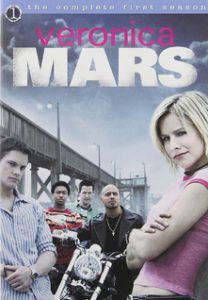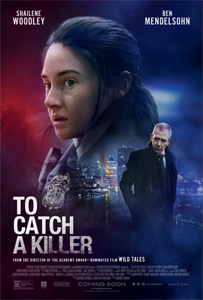The detective thriller “To Catch a Killer” is caught between old-fashioned and modern, grungy and slick – elevated so much above its script by Shailene Woodley and Ben Mendelsohn that one could mistake it for an underachieving A-list picture rather than an overachieving B-lister.
Director/co-writer Damian Szifron comments on our times of random big-city violence, idiotic punditry and social chilliness, but not in a surprising way. The movie makes sure to have the major modern political viewpoints represented by someone. If “To Catch a Killer” has an overarching statement, it might be that everyone is a pathetic victim of this pathetic mess.
Messy modern times
But to say that the messiness is the point is to give it too much credit, as “Killer” regularly diverts to other issues. It’s not bad that we get to know our two leads, who bring human warmth to the procedural, but ultimately I think the procedural pleasures (and frustrations) are meant to be the point. Everything else is tacked on and doesn’t quite stick.
“Killer” shows the flaws of an FBI where most of the decisions are influenced by office politics, yet its heroes are an FBI chief (Mendelsohn’s Lammark) and a potential future star (Woodley’s Eleanor). Ralph Ineson comes in late with a great single-scene monologue, but because of the nature of his character, his fair points become muted.
“To Catch a Killer” (2023)
Director: Damián Szifron
Writers: Damián Szifron, Jonathan Wakeham
Stars: Shailene Woodley, Ben Mendelsohn, Jovan Adepo
The movie consistently looks good under the lens of Javier Julia, but without a singular sense of place. Quebec stands in for Baltimore – an odd juxtaposition to start with. Swank New Year’s Eve parties atop skyscrapers are interrupted by pinpoint sniper shots at seemingly random victims.
Later, we get a mall mass shooting; it’s hard to imagine Baltimore still has a thriving, clean, bright mall. Other moments do capture the depressing grit of a collapsing city, with the snow cover providing a beauty that’s almost poignant in its falsity. A rural shack amid a biting winter adds atmosphere.
The veteran and the novice
Also good are the two leads, in that classic mentor-and-newbie law-enforcement partnership. At first blush, it’s funny that Woodley is playing a gruff detective, but her soft features double as tired features, and she’s believable. Mendelsohn projects his usual competence and decency despite Lammark being so brutalized by superiors looking to cover their rears that it’s remarkable he has time to do his job.
Keeping “To Catch a Killer” stuck like quicksand in the realm of “good” rather than “great” is that Szifron and cowriter Jonathan Wakeham can’t settle on a point. They throw lots of stuff at the screen, and overexplain all of it in the moment. They don’t do any pre-sorting for the viewer, yet nor do they trust us to find our own meaning.

“To Catch a Killer” at times laments society’s loss of freedom, and at other times glories in technology that provides instant information. The location of the sniper nest is found before the firework tubes have even cooled, as the experts come in with laser pointers that backtrack the bullets based on angle of entry.
The film loves tech and tactical maneuvers and assumes a sci-fi level of competency from the FBI while also being disgusted by its stultifying office politics. Our two heroes can’t escape the BS, and are basically resigned to their fates. We get an unearned happy ending that’s also pseudo-cynical. By always having it both ways, the film has it no way.
That said, “To Catch a Killer” is absorbing enough thanks to the leads and the way it looks. It catches one’s attention and holds up for one viewing, but it’s less likely to catch one’s permanent fancy.

